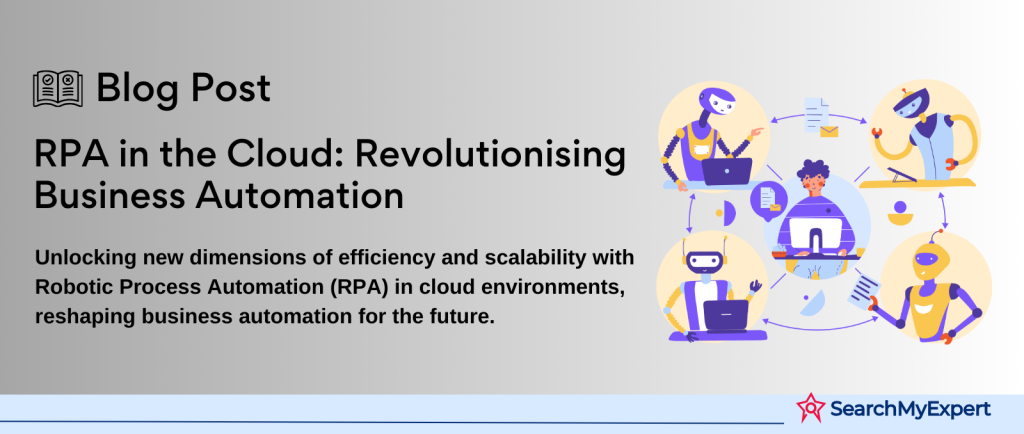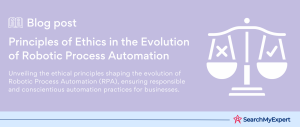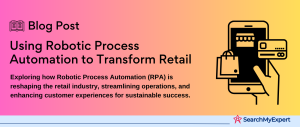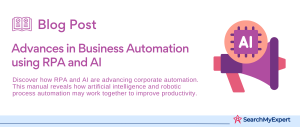Cloud-Based Solutions in Robotic Process Automation: An Innovative Leap
Embracing the Future: Robotic Process Automation (RPA) Unraveled
Robotic Process Automation (RPA) stands as a revolutionary technology that automates mundane, repetitive tasks traditionally done by humans. Picture a virtual workforce, tirelessly executing tasks with precision and speed, freeing human counterparts for more creative and strategic endeavors. The core benefits? Astounding efficiency, error reduction, and significant cost savings.
Soaring High: The Rise of Cloud-Based RPA
As technology advances, RPA is not just confined to local servers. Enter Cloud-Based RPA – a modern twist offering RPA solutions via the cloud. Its popularity is not by chance but by merit. This paradigm shift is driven by the cloud’s innate ability to offer scalability, agility, and accessibility, characteristics essential in today’s fast-paced business world.
Cloud vs. On-Premise: The Advantages of Cloud-Based RPA
Switching to cloud-based RPA is not just a trend; it’s a strategic move. Compared to traditional on-premise solutions, cloud-based RPA stands out with its:
- Scalability:
Effortlessly scales up or down based on demand. - Accessibility:
Allows remote access, broadening the scope of operations. - Cost-Effectiveness: Reduces upfront investments in infrastructure.
- Agility: Rapid deployment and updates keep businesses at the forefront.
Cloud-based RPA is not just an option but a necessary evolution in the realm of automation, propelling businesses toward unparalleled efficiency and innovation.
Understanding Cloud RPA
Key Components of a Cloud-Based RPA Platform
Cloud-based RPA platforms, an epitome of efficiency and innovation, comprise several critical components:
- User Interface (UI):
This is the gateway to the platform, where users interact, design, and monitor bots. The UI is intuitive, enabling users to effortlessly manage their automation processes. - Bot Management Console: The command center for all RPA bots. Here, administrators can deploy, schedule, and manage the bot workforce, ensuring smooth operation and compliance.
- Execution Environment:
This is where the magic happens. Bots execute tasks within this cloud-based environment, leveraging the cloud’s vast resources for optimal performance.
Working Principle of Cloud RPA: A Simple Example
Imagine a bot named “Cloudy,” designed to automate invoice processing – a typically mundane and repetitive task. Here’s how Cloudy brings efficiency into play:
- Retrieval: Cloudy accesses the cloud storage to retrieve new invoices.
- Data Extraction: It reads and extracts relevant data from the invoices.
- Processing: The data is then processed and matched with the corresponding purchase orders.
- Updating Systems:
Finally, Cloudy updates the accounting system and archives the processed invoices.
This example illustrates how cloud RPA can transform a time-consuming process into a swift, error-free operation, allowing human employees to focus on more strategic tasks.
Benefits of Cloud-Based RPA
Scalability and Flexibility: The Power to Adapt
Cloud-based RPA stands out for its scalability and flexibility. Businesses can easily adjust the number of bots to match their changing needs. This dynamism ensures that companies are always at the right scale for their automation requirements, whether during peak periods or in times of reduced demand.
Cost-Effectiveness: A Financially Savvy Choice
Cost-effectiveness is a hallmark of cloud RPA. By eliminating the need for hefty upfront infrastructure investments and ongoing maintenance costs, it offers a more financially viable option. Companies can enjoy the benefits of RPA without the burden of substantial initial expenses, making it a smart choice for businesses of all sizes.
Accessibility and Collaboration: Work Without Boundaries
The accessibility and collaboration features of cloud RPA are game-changers. With cloud-based platforms, team members can access and work on automation projects from anywhere in the world, provided they have an internet connection. This feature not only enhances productivity but also fosters a collaborative environment, crucial for innovative solutions.
Security and Compliance: A Trustworthy Fortress
Security and compliance are top priorities in cloud RPA platforms. These systems are designed with robust security features to protect sensitive data and ensure compliance with various data privacy regulations. Users can trust that their data is safe and their operations are in line with legal standards, providing peace of mind in a digital age.
Key Use Cases for Cloud RPA in Different Industries
Finance and Banking: Revolutionizing Traditional Processes
In Finance and Banking, cloud RPA shines by automating:
- Account Reconciliation:
Bots reconcile transactions swiftly, ensuring accuracy and reducing the time spent on manual checks. - Loan Processing:
From application to approval, RPA streamlines the loan processing workflow, improving efficiency and customer experience. - Customer Onboarding: Automating data entry and verification processes, RPA accelerates customer onboarding, enhancing satisfaction and compliance.
Healthcare: Enhancing Care through Automation
In Healthcare, cloud RPA offers significant improvements by:
- Streamlining Administrative Tasks: Bots handle scheduling, billing, and claims processing, freeing staff for patient care.
- Improving Patient Data Accuracy:
RPA ensures accurate patient records, reducing errors and enhancing treatment outcomes. - Automating Appointment Scheduling:
Patients can easily schedule appointments, with bots managing calendars and reminders.
Manufacturing: Boosting Efficiency and Quality
In Manufacturing, cloud RPA optimizes operations through:
- Production Line Monitoring:
Bots monitor production lines, identifying issues early to prevent downtime. - Quality Control Checks:
Automated checks ensure consistent product quality, reducing manual inspection needs. - Inventory Management: RPA bots track and manage inventory levels, ensuring optimal stock availability.
Retail and E-commerce: Transforming Customer Experience
In Retail and E-commerce, cloud RPA enhances customer engagement by:
- Automating Order Processing: Bots process orders efficiently, ensuring timely delivery and customer satisfaction.
- Handling Customer Service Interactions: RPA assists in handling queries, and providing quick and accurate responses.
- Price Comparison:
Bots perform real-time price comparisons, aiding in competitive pricing strategies.
Implementing Cloud RPA
Navigating the Path to Cloud RPA Implementation
Implementing a cloud RPA solution involves a structured approach:
- Initial Assessment: Begin by identifying processes suitable for automation. Look for tasks that are repetitive, rule-based, and have high volumes.
- Selecting the Right Platform:
Choose a cloud RPA platform that aligns with your business needs and scalability requirements. - Process Mapping:
Map out the specific processes to be automated. This step is crucial for understanding the workflow and identifying potential challenges. - Bot Development: Develop RPA bots tailored to your specific processes. This involves programming the bots to execute the mapped tasks.
- Testing:
Rigorously test the bots in a controlled environment to ensure they function as intended. - Deployment:
Deploy the bots into the live environment. Start with a small scale and gradually expand as confidence in the system grows. - Monitoring and Maintenance:
Continuously monitor the performance of the RPA bots and perform regular maintenance to ensure optimal efficiency.
Resources and Best Practices for Successful Implementation
For a successful cloud RPA implementation, consider the following resources and best practices:
- Training and Education: Ensure your team is well-trained in RPA technology and cloud management.
- Partner with Experts: Collaborate with RPA consultants or partners for specialized expertise.
- Continuous Improvement:
Regularly review and update the RPA processes to adapt to changing business needs. - Security and Compliance:
Always prioritize security and compliance, especially when dealing with sensitive data.
Challenges and Considerations of Cloud RPA
Navigating Through Potential Roadblocks
Implementing cloud RPA, while beneficial, comes with its set of challenges:
- Data Security Concerns: With sensitive data being processed, security is paramount. There’s a constant need to protect against breaches and ensure data privacy.
- Integration with Existing Systems:
Ensuring smooth integration of RPA with current systems can be complex, particularly if these systems are outdated or use different standards. - Change Management: Adopting RPA involves significant changes in workflow and employee roles, which can lead to resistance within the organization.
Overcoming Challenges: Strategies for a Smooth Transition
To address these challenges, consider the following strategies:
- Robust Security Measures: Implement stringent security protocols, including data encryption,
access control, and regular security audits. - Collaboration with IT Experts:
Work closely with IT experts to ensure seamless integration of RPA into existing systems, taking care to align with existing IT architectures. - Effective Change Management: Foster a culture of change through training and communication, ensuring all stakeholders understand the benefits and changes brought by RPA.
- Pilot Programs:
Start with pilot programs to test and refine the RPA system before full-scale implementation, allowing for adjustments and learning.
Harnessing the Power of Cloud RPA: A Game-Changer in Automation
As we’ve journeyed through the world of cloud-based RPA, several key takeaways have emerged:
- Transformation Across Industries:
Cloud RPA is not just a tool but a revolution in business automation, applicable across various sectors like finance, healthcare, manufacturing, and retail. - Dynamic and Cost-Effective: Offering unparalleled scalability, flexibility, and cost-effectiveness, cloud RPA empowers businesses to adapt and grow in a fast-paced digital landscape.
- Enhancing Efficiency and Accuracy:
By automating routine tasks, cloud RPA frees human talent to focus on more strategic initiatives, while increasing operational efficiency and accuracy. - Accessibility and Collaboration:
With its global accessibility, cloud RPA fosters collaboration and innovation, breaking down geographical and logistical barriers. - Navigating Challenges: While challenges like data security and integration exist, strategic planning and robust solutions ensure a smooth transition to this innovative technology.
Conclusion
The potential of cloud-based RPA to revolutionize business processes is immense. It’s an opportunity for organizations to redefine their operations, enhance efficiency, and stay ahead in a competitive market. We encourage businesses to explore the possibilities of cloud RPA and harness its potential benefits, propelling towards a future where automation is not just an option, but a necessity for growth and innovation.
Unlock new efficiencies with top-tier Robotic Process Automation Service Agencies.
Further Reading
- Robotic Process Automation for Data Management
- Robotic Process Automation in Supply Chain Management
- Robotic Process Automation in Manufacturing
- Building a Robotic Process Automation Center of Excellence
- Robotic Process Automation and Digital Transformation
- Robotic Process Automation for Small and Medium Enterprises
Table of Contents
Toggle






